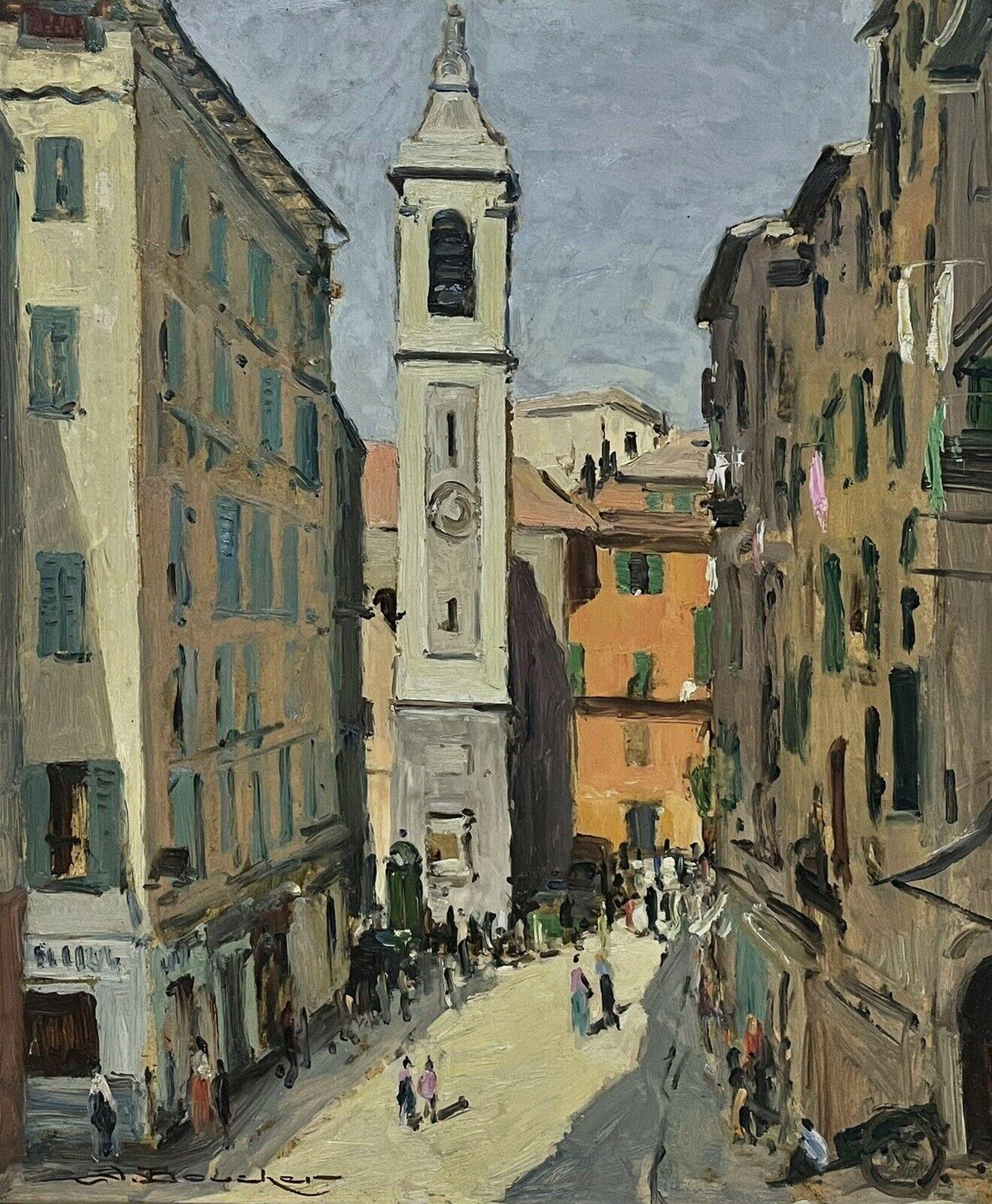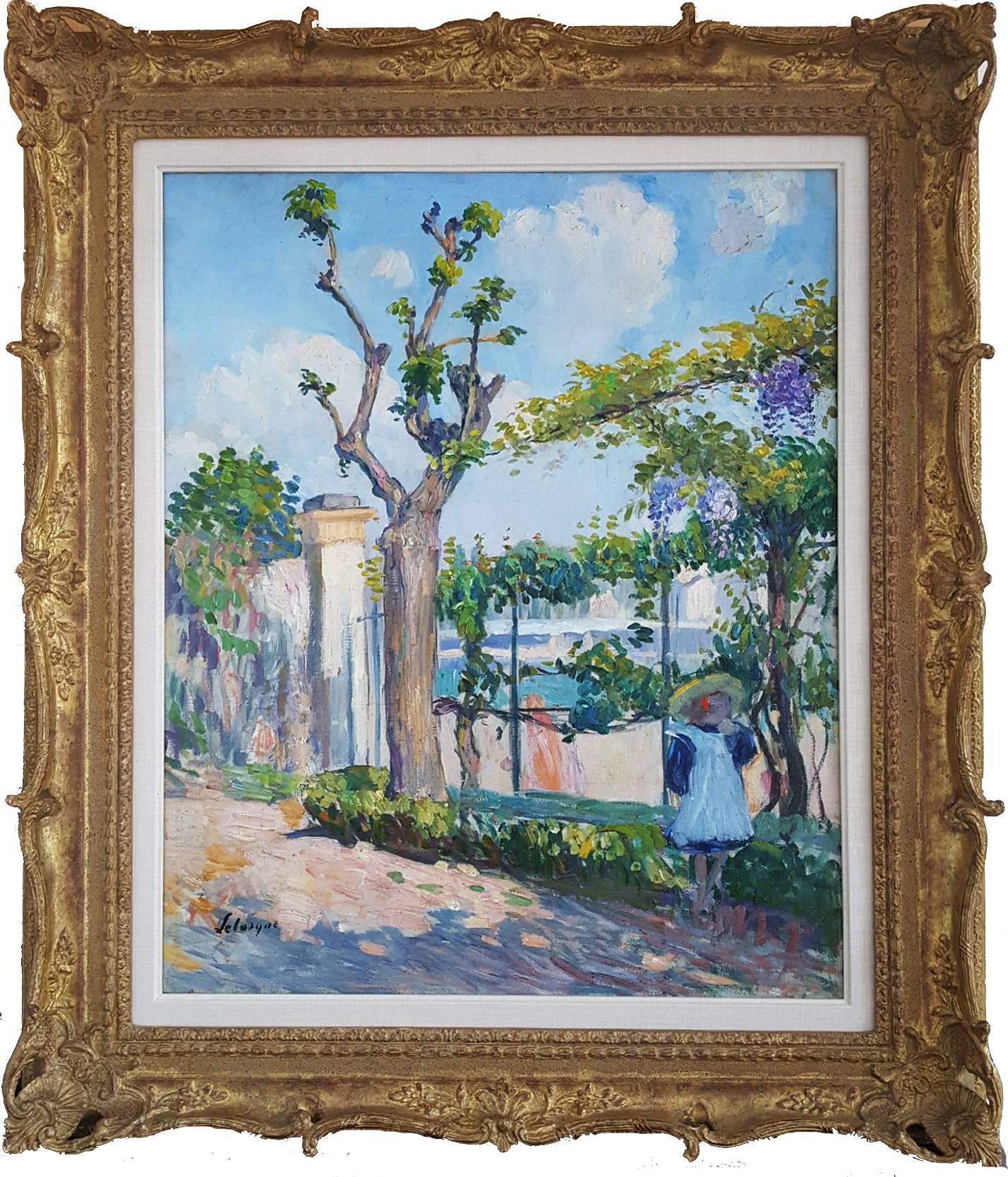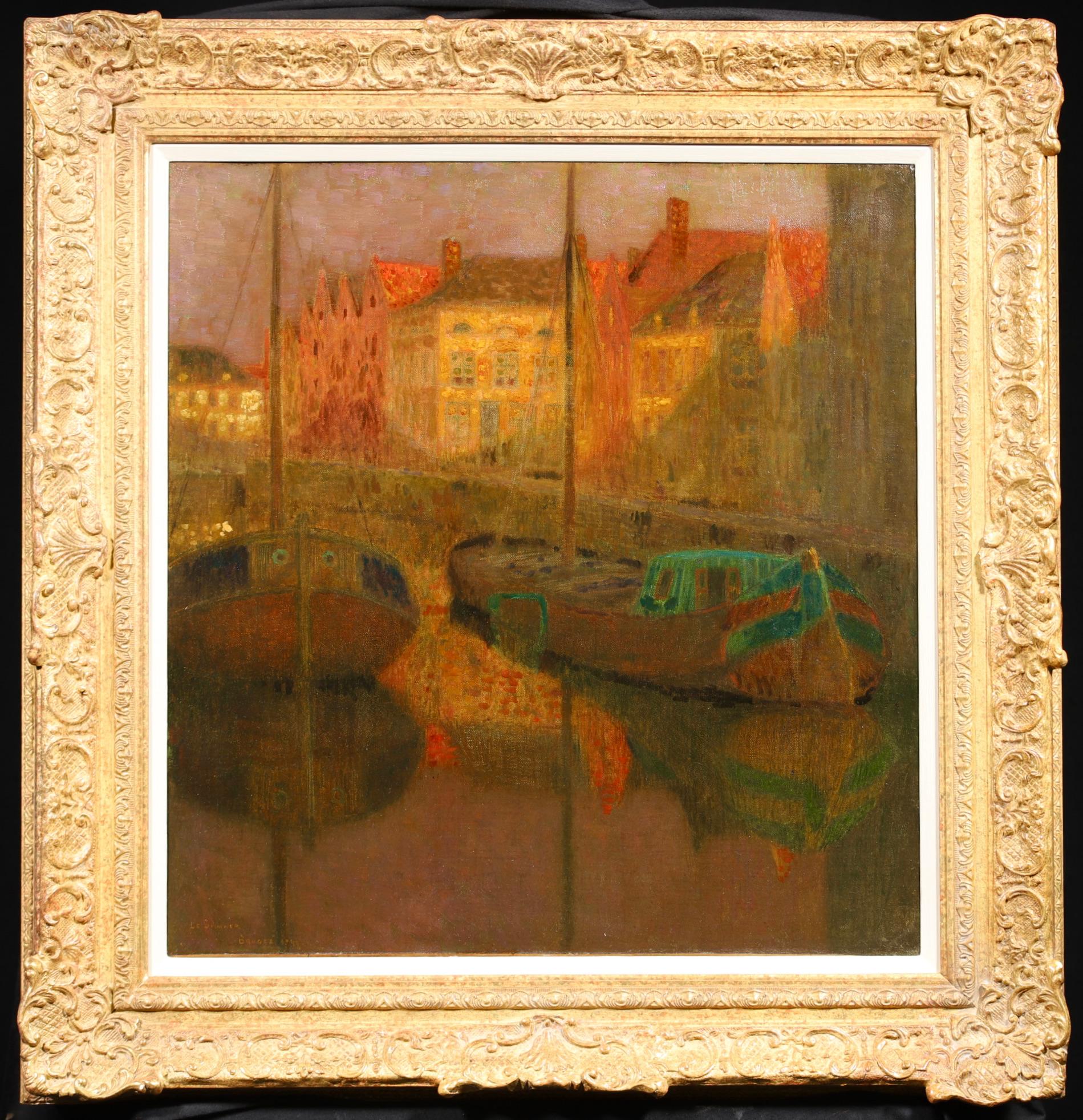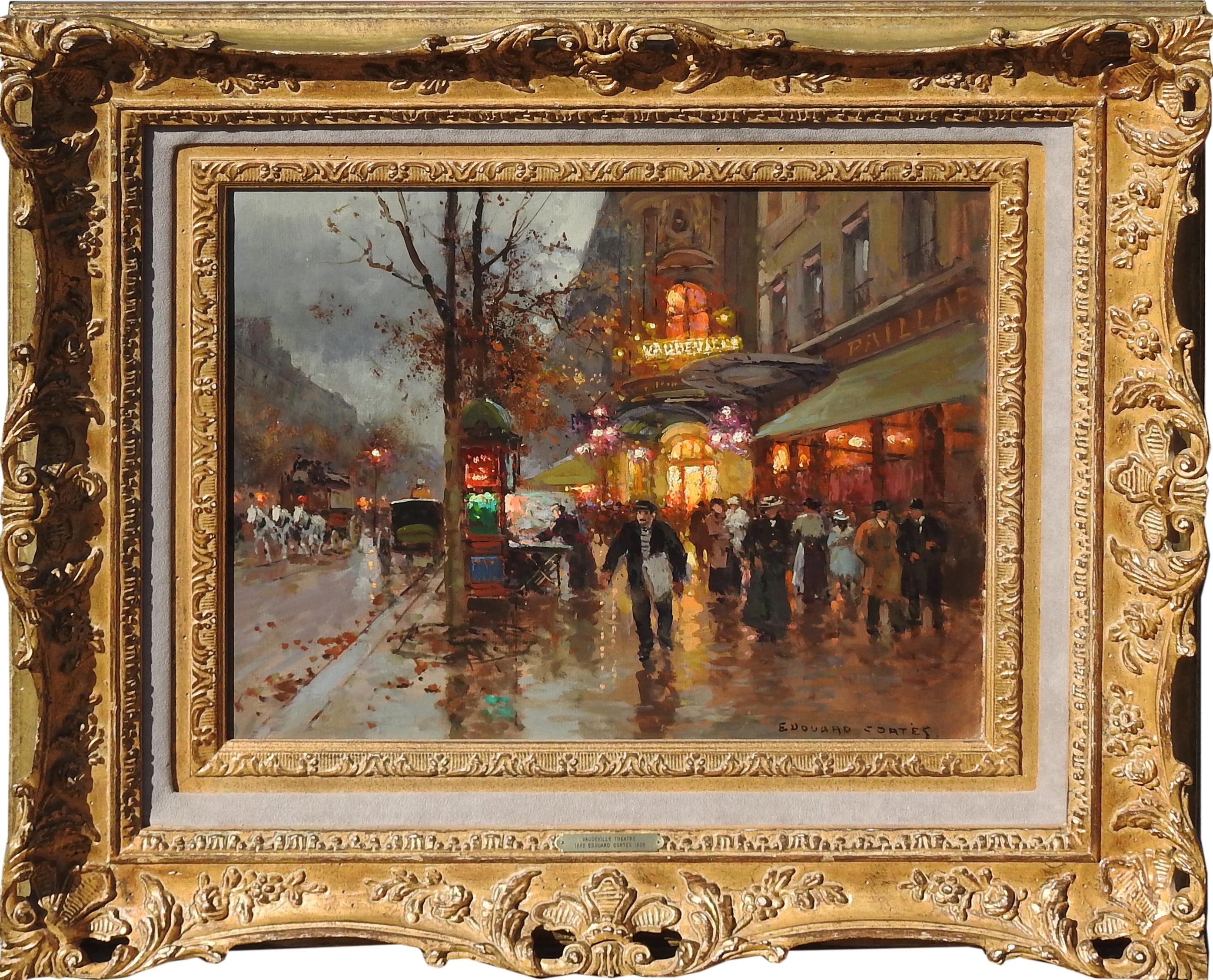Items Similar to Octave Denis Victor Guillonnet (1872 - 1967) Les Oliviers, oil on panel signed
Video Loading
Want more images or videos?
Request additional images or videos from the seller
1 of 17
Octave GuillonnetOctave Denis Victor Guillonnet (1872 - 1967) Les Oliviers, oil on panel signedcirca 1950
circa 1950
About the Item
Octave Denis Victor Guillonnet (1872 - 1967)
Les Oliviers, A landscape with olive trees
signed "EODV Guillonnet" lower right
Oil on wood panel
38 x 46 cm
Framed : 44 x 52 cm
Provenance :
Galerie Selection, Tunis (see the label on the reverse)
Private collection, France
In good condition, a thin line of cracks in the wood can be seen in the bottom right-hand corner (see detail photograph please)
This painting is very representative of the works produced by Guillonnet when he devoted himself to depicting the landscapes of the Nice region, where he lived for part of the year. It is clearly marked by a post-impressionist style that is freer and more lively than his more formal compositions.
Octave Denis Victor Guillonnet was born in Paris on 22 September 1872,
He entered the studio of the painter Lionel Royer as an apprentice.
Besides Royer, Guillonnet's other teachers included Joseph Blanc and Fernand Cormon at the École des Beaux-Arts in Paris.
From 1887 onwards, he exhibited his most recent works at the Salon des Artistes Français, as he did every year thereafter until his death. For the 1900 Universal Exhibition in Paris, Guillonnet created a monumental decoration representing Asia, Africa and America for the pavilion of the Ministry of Colonies, where he was awarded a silver medal.
Before the First World War, Guillonnet began to be represented by the gallery owner Georges Petit. During the war, Guillonnet took refuge in the South of France. Guillonnet devoted himself to his work on the shores of the Mediterranean, painting the thousand facets of female bodies draped in colourful veils where wind and light play.
On graduating from the École des Beaux-Arts, Guillonnet produced illustrations commissioned by publishers, but above all portraits, which introduced him to the upper middle classes.
He became friends with Pierre-Emmanuel Clergue, a lawyer and future mayor of the town of Carros (Alpes-Maritimes). In 1899, Clergue invited him to come and stay in Carros and provided him with a building known as "La Forge", which he used until the end of his life in 1967.
Guillonnet was buried next to his first wife in the Carros cemetery. The epitaph on his grave reads: "Étions deux, N'avions qu'un cœur" (Were two, Had but one heart).
Guillonnet never appreciated his first names. At the start of his career, he signed his name "Octave Guillonnet". For a time, he also signed his name "Victor Guillonnet", but soon abandoned this and added his initials to his surname: "ODV Guillonnet". The "E" in his signature from 1931 onwards stands for Eugénie, his wife's first name. It was after her death that Guillonnet added the "E" to his first names in
In 1902, Guillonnet exhibited two works at the Salon des artistes français, and the Salon jury awarded him the national prize, which included a travel grant of 4,000 francs to enable him to spend a year in Algeria.
This year in Algeria proved to be a decisive turning point in Guillonnet's career. He was profoundly influenced by the light and luminous colours of North Africa. Guillonnet developed his interest in "half-shadow" painting and embraced the post-impressionist painters' theories of colour contrast.
Guillonnet's main decorations include the following:
The visiting room at the Lycée Lakanal in Sceaux: Guillonnet's first monumental decoration was for the visiting room at the Lycée Lakanal in Sceaux.
Salle des Cariatides at Paris City Hall: in 1927, Guillonnet decorated the Salle des Cariatides overlooking the main entrance.
Salle des fêtes de la mairie du 15e arrondissement de Paris: Guillonnet was responsible for the central composition of the monumental décor on canvas for the vaulted ceiling of the Salle des fêtes in the 15th arrondissement of Paris.
The Casa Amarilla in Caracas, Venezuela: Guillonnet decorated the patio of the Casa Amarilla, the headquarters of the Venezuelan Ministry of Foreign Affairs in Caracas.
Le Broc church: in 1939, Guillonnet decorated the entire church of Le Broc, a village in the Alpes-Maritimes next to Carros.
Église Saint-Étienne de Jargeau: in November 1952, in memory of his grandmother, Guillonnet delivered a Way of the Cross in shades of green to the church of Saint-Étienne de Jargeau.
He was also a well-known illustrator.
His works are held in various museums, including those in Bordeaux, Dijon, Nantes, Tourcoing and the Musée d'Art Moderne de la Ville de Paris.
Diego Rivera, the Mexican muralist, chose Guillonnet's studio to work with him when he visited Paris in 1908-1909.
- Creator:Octave Guillonnet (1872 - 1967, French)
- Creation Year:circa 1950
- Dimensions:Height: 14.97 in (38 cm)Width: 18.12 in (46 cm)
- Medium:
- Movement & Style:
- Period:
- Condition:
- Gallery Location:Paris, FR
- Reference Number:
About the Seller
5.0
Platinum Seller
These expertly vetted sellers are 1stDibs' most experienced sellers and are rated highest by our customers.
Established in 2018
1stDibs seller since 2019
210 sales on 1stDibs
Typical response time: <1 hour
- ShippingRetrieving quote...Ships From: Paris, France
- Return PolicyA return for this item may be initiated within 14 days of delivery.
More From This SellerView All
- Maurice Asselin (1882-1947) Notre-Dame, Paris Oil on canvas, signedBy Maurice AsselinLocated in Paris, FRMaurice Asselin (1882-1947) Notre-Dame, Paris Signed lower left, Oil on canvas 50 x 61 cm In good condition In its original frame : 61 x 72 cm It is really interesting to reme...Category
1930s Post-Impressionist Figurative Paintings
MaterialsOil
- Jean Robert Ithier (1904-1977) Ars en Ré, view of the church, oil on canvasBy JEAN ROBERT ITHIERLocated in Paris, FRJean Robert Ithier (1904-1977) Ars en Ré, view of the church oil on canvas signed lower left 80.5 x 60 cm No frame The church of Ars en Ré, a pittoresque village on the atlantic i...Category
1950s Post-Impressionist Landscape Paintings
MaterialsOil
- Léon Frédéric (1856-1940) Vallée de Nafraiture, Oil on panelBy Léon FrédéricLocated in Paris, FRLéon Frédéric (1856-1940) Vallée de Nafraiture signed with the estate stamp at the lower left Oil on canvas transfered on panel 29.5 x 44.55 cm Certific...Category
1930s Post-Impressionist Landscape Paintings
MaterialsOil
- French school end of 19th century, A seaside with two characters, oil on paperLocated in Paris, FRFrench school end of 19th century Seaside with two characters, oil on paper 27 x 49 cm In good condition In a modern frame : 35 x 57 cmCategory
1890s French School Landscape Paintings
MaterialsOil
- Charles Montlevault (1835-1897) Walkers along a cliff, oil painting signedLocated in Paris, FRCharles Montlevault (1835-1897) Walkers along a cliff Signed lower left Oil on canvas 35 x 27 cm in good condition In a vintage frame : 57.5 x 50 cm unfortunately damaged with impor...Category
1870s Barbizon School Landscape Paintings
MaterialsOil
- French School 19th century, Animated dune landscape, oil on panelLocated in Paris, FRFrench School mid 19th Century Animated dune landscape, oil on cardboard panel 12.4 x 29.8 cm bears a small inscription "Escoublac" on the lower right, not visible under the actual ...Category
1850s Barbizon School Landscape Paintings
MaterialsOil
You May Also Like
- Bords du Loing by Alfred Sisley - Oil, landscape paintingBy Alfred SisleyLocated in London, GB*THIS PRICE INCLUDES 5% IMPORT DUTY APPLICABLE IF THE WORK REMAINS IN THE UK ONLY. Bords du Loing by Alfred Sisley (1839-1899) Oil on canvas 46.1 x 55.7 cm (18¹/₈ x 21⁷/₈ inches) S...Category
1890s Post-Impressionist Landscape Paintings
MaterialsCanvas, Oil
- Large Mid 20th Century French Signed Post-Impressionist Oil - Busy City StreetLocated in Cirencester, GloucestershireArtist/ School: Amedee Boucher, French mid 20th century, signed lower corner Title: Busy French street scene Medium: signed oil painting on board fram...Category
Mid-20th Century Post-Impressionist Landscape Paintings
MaterialsOil
- Le Jardin de Lagny - Garden with young girl Post-impressionistBy Henri LebasqueLocated in Miami, FLLe Jardin de Lagny Provenance: Arthur Tooth, London Radon Gallery, NY This beautiful evocation of a lyrical French landscape is a fine example of of Po...Category
Early 1900s Post-Impressionist Landscape Paintings
MaterialsOil, Canvas
- Barques de Peche - Post Impressionist Landscape Oil by Henri Le SidanerBy Henri Le SidanerLocated in Marlow, BuckinghamshireSigned post impressionist landscape oil on canvas by French painter Henri Le Sidaner. This stunning piece depicts two fishing boats moored in a fishing village at sunset. The last l...Category
1890s Post-Impressionist Landscape Paintings
MaterialsOil, Canvas
- "Theatre du Vaudeville", Edouard Cortes, 18x22, Oil/Canvas, French ImpressionismLocated in Dallas, TXVaudeville Theatre by Edouard Cortes was painted circa 1955-60 and signed lower left. It is oil on canvas measuring 18x22 in original unlined condition....Category
1950s Post-Impressionist Landscape Paintings
MaterialsOil, Canvas
- "Theatre de Sara Barnhardt", Edouard Cortes, 13x18, Oil on Canvas, ImpressionismLocated in Dallas, TXTheatre de Sara Bernhart et Place de Chatelet by Edouard Cortes was painted circa 1935-40 and signed lower right. It is an oil on canvas measuring 13x18...Category
1930s Post-Impressionist Landscape Paintings
MaterialsOil, Canvas





